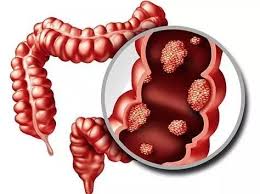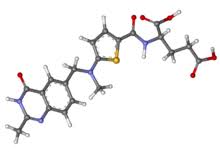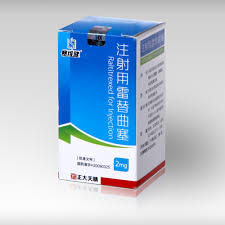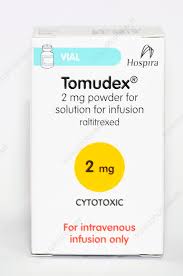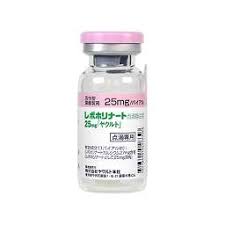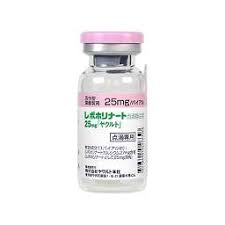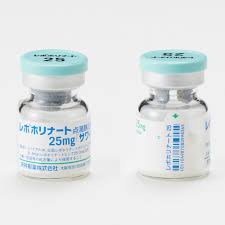雷莫芦单抗重组冻干粉注射剂Cyramza Injection 100mg/10ml
 药店国别:
产地国家:日本
处方药:是
所属类别: 100毫克/10毫升/瓶
包装规格: 100毫克/10毫升/瓶
计价单位:瓶
生产厂家中文参考译名:
生产厂家英文名:Eli Lilly
原产地英文商品名:CYRAMZA INJECTION100mg/10mL/vials
原产地英文药品名:Ramucirumab(Genetical Recombination)
中文参考商品译名:CYRAMZA注射溶液100毫克/10毫升/瓶
中文参考药品译名:雷莫芦单抗基因重组
药店国别:
产地国家:日本
处方药:是
所属类别: 100毫克/10毫升/瓶
包装规格: 100毫克/10毫升/瓶
计价单位:瓶
生产厂家中文参考译名:
生产厂家英文名:Eli Lilly
原产地英文商品名:CYRAMZA INJECTION100mg/10mL/vials
原产地英文药品名:Ramucirumab(Genetical Recombination)
中文参考商品译名:CYRAMZA注射溶液100毫克/10毫升/瓶
中文参考药品译名:雷莫芦单抗基因重组
简介
英文药名:Cyramza Injection(Ramucirumab(GeneticalRecombination)) 中文药名:雷莫芦单抗[重组]冻干粉末 生产厂家:礼来制药 类别名称:抗肿瘤剂源化抗VEGFR-2注)单克隆抗体注:VEGFR-2:血管内皮生长因子受体-2(血管内皮生长因子受体2) 上市批准:2015年6月 商標名:CyramzaInjection 一般名:人造丝绒(遺伝子組換え)(JAN)Ramucirumab(GeneticalRecombination) 本 质:Ramucirumab是人血管内皮生长因子受体2的胞外域的重组人IgG1单克隆抗体。Ramucirumab通过小鼠骨髓瘤细胞(NS0)制备。Ramucirumab446件的H链(γ1链)的组成的氨基酸残基2和214个氨基酸残基(κ链)2在由糖蛋白L链(分子量:约147000)是。 药效药理 1.作用机序Ramucirumab是针对人VEGFR-2的抗体,通过抑制VEGF-A的结合,对VEGFR-2的VEGF-C和VEGF-D,9,以抑制VEGFR-2的活性)。Ramucirumab是通过活化抑制VEGFR-2的,被认为是内皮细胞增殖,抑制迁移和存活,抑制肿瘤血管生成。 2.抗肿瘤効果从胃癌患者和从裸鼠的MKN-45细胞来源的人胃癌癌组织标本皮下植入,(针对小鼠VEGFR-2的抗体)DC101出现一个肿瘤生长抑制作用。 适应病症 不能手术切除,晚期或复发性胃癌不能切除的晚期或复发性结直肠癌 用法与用量 一次为8mg/kg体重的时间内大约60分钟滴输液作为Ramucirumab(基因重组)在两周于成年人。另外,适当的病人的病情。 包装规格注射: 100毫克:1瓶(10毫升)注射:500毫克:1瓶(50毫升英文版说明书
IMPORTANT SAFETY INFORMATION FOR CYRAMZAWARNING: HEMORRHAGE, GASTROINTESTINAL PERFORATION, AND IMPAIRED WOUND HEALINGHemorrhage: CYRAMZA increased the risk of hemorrhage and gastrointestinal hemorrhage, including severe and sometimes fatal hemorrhagic events. Permanently discontinue CYRAMZA in patients who experience severe bleeding.Gastrointestinal Perforation: CYRAMZA can increase the risk of gastrointestinal perforation, a potentially fatal event. Permanently discontinue CYRAMZA in patients who experience a gastrointestinal perforation.Impaired Wound Healing: Impaired wound healing can occur with antibodies inhibiting the VEGF pathway. Discontinue CYRAMZA therapy in patients with impaired wound healing. Withhold CYRAMZA prior to surgery and discontinue CYRAMZA if a patient develops wound healing complications.Warnings and PrecautionsHemorrhageCYRAMZA increased the risk of hemorrhage and gastrointestinal hemorrhage including severe and sometimes fatal hemorrhagic events. In study 1, which eva luated CYRAMZA as a single agent in advanced gastric cancer, the incidence of severe bleeding was 3.4% for CYRAMZA and 2.6% for placebo. In study 2, which eva luated CYRAMZA plus paclitaxel in advanced gastric cancer, the incidence of severe bleeding was 4.3% for CYRAMZA plus paclitaxel and 2.4% for placebo plus paclitaxel. Patients with gastric cancer receiving nonsteroidal anti-inflammatory drugs (NSAIDs) were excluded from enrollment in studies 1 and 2; therefore, the risk of gastric hemorrhage in CYRAMZA-treated patients with gastric tumors receiving NSAIDs is unknown. In study 3, which eva luated CYRAMZA plus docetaxel in metastatic non-small cell lung cancer (NSCLC), the incidence of severe bleeding was 2.4% for CYRAMZA plus docetaxel and 2.3% for placebo plus docetaxel. Patients with NSCLC receiving therapeutic anticoagulation or chronic therapy with NSAIDs or other antiplatelet therapy other than once-daily aspirin or with radiographic evidence of major airway or blood vessel invasion or intratumor cavitation were excluded from study 3; therefore, the risk of pulmonary hemorrhage in these groups of patients is unknown. In study 4, which eva luated CYRAMZA plus FOLFIRI in metastatic colorectal cancer, the incidence of severe bleeding was 2.5% for CYRAMZA plus FOLFIRI and 1.7% for placebo plus FOLFIRI. Permanently discontinue CYRAMZA in patients who experience severe bleeding.Arterial Thromboembolic Events (ATEs)Serious, sometimes fatal, ATEs including myocardial infarction, cardiac arrest, cerebrovascular accident, and cerebral ischemia occurred in clinical trials including 1.7% of 236 patients who received CYRAMZA as a single agent for gastric cancer in study 1. Permanently discontinue CYRAMZA in patients who experience a severe ATE.HypertensionAn increased incidence of severe hypertension occurred in patients receiving CYRAMZA as a single agent (8%) as compared to placebo (3%), in patients receiving CYRAMZA plus paclitaxel (15%) as compared to placebo plus paclitaxel (3%), and in patients receiving CYRAMZA plus docetaxel (6%) as compared to placebo plus docetaxel (2%), and in patients receiving CYRAMZA plus FOLFIRI (11%) as compared to placebo plus FOLFIRI (3%). Control hypertension prior to initiating treatment with CYRAMZA. Monitor blood pressure every 2 weeks or more frequently as indicated during treatment. Temporarily suspend CYRAMZA for severe hypertension until medically controlled. Permanently discontinue CYRAMZA if medically significant hypertension cannot be controlled with antihypertensive therapy or in patients with hypertensive crisis or hypertensive encephalopathy.Infusion-Related Reactions (IRRs)Prior to the institution of premedication recommendations across clinical trials of CYRAMZA, IRRs occurred in 6 out of 37 patients (16%), including 2 severe events. The majority of IRRs across trials occurred during or following a first or second CYRAMZA infusion. Symptoms of IRRs included rigors/tremors, back pain/spasms, chest pain and/or tightness, chills, flushing, dyspnea, wheezing, hypoxia, and paresthesia. In severe cases, symptoms included bronchospasm, supraventricular tachycardia, and hypotension. Monitor patients during the infusion for signs and symptoms of IRRs in a setting with available resuscitation equipment. Immediately and permanently discontinue CYRAMZA for grade 3 or 4 IRRs.Gastrointestinal PerforationsCYRAMZA is an antiangiogenic therapy that can increase the risk of gastrointestinal perforation, a potentially fatal event. Four of 570 patients (0.7%) who received CYRAMZA as a single agent in advanced gastric cancer clinical trials experienced gastrointestinal perforation. In study 2, the incidence of gastrointestinal perforation was 1.2% for CYRAMZA plus paclitaxel as compared to 0.3% for placebo plus paclitaxel. In study 3, the incidence of gastrointestinal perforation was 1% for CYRAMZA plus docetaxel as compared to 0.3% for placebo plus docetaxel. In study 4, the incidence of gastrointestinal perforation was 1.7% for CYRAMZA plus FOLFIRI and 0.6% for placebo plus FOLFIRI. Permanently discontinue CYRAMZA in patients who experience a gastrointestinal perforation.Impaired Wound HealingImpaired wound healing can occur with antibodies inhibiting the VEGF pathway. CYRAMZA has not been studied in patients with serious or nonhealing wounds. CYRAMZA, an antiangiogenic therapy, has the potential to adversely affect wound healing. Discontinue CYRAMZA therapy in patients with impaired wound healing. Withhold CYRAMZA prior to surgery. Resume CYRAMZA following the surgical intervention based on clinical judgment of adequate wound healing. If a patient develops wound healing complications during therapy, discontinue CYRAMZA until the wound is fully healed.Clinical Deterioration in Child-Pugh B or C CirrhosisClinical deterioration, manifested by new onset or worsening encephalopathy, ascites, or hepatorenal syndrome, was reported in patients with Child-Pugh B or C cirrhosis who received single-agent CYRAMZA. Use CYRAMZA in patients with Child-Pugh B or C cirrhosis only if the potential benefits of treatment are judged to outweigh the risks of clinical deterioration.Reversible Posterior Leukoencephalopathy Syndrome (RPLS)RPLS has been reported at a rate of <0.1% in clinical studies with CYRAMZA. Confirm the diagnosis of RPLS with MRI and discontinue CYRAMZA in patients who develop RPLS. Symptoms may resolve or improve within days, although some patients with RPLS can experience ongoing neurologic sequelae or death.Proteinuria Including Nephrotic SyndromeIn study 4, severe proteinuria occurred more frequently in patients treated with CYRAMZA plus FOLFIRI compared to patients receiving placebo plus FOLFIRI. Severe proteinuria was reported in 3% of patients treated with CYRAMZA plus FOLFIRI (including 3 cases [0.6%] of nephrotic syndrome) compared to 0.2% of patients treated with placebo plus FOLFIRI. Monitor proteinuria by urine dipstick and/or urinary protein creatinine ratio for the development of worsening of proteinuria during CYRAMZA therapy. Withhold CYRAMZA for urine protein levels that are ≥2 g over 24 hours. Reinitiate CYRAMZA at a reduced dose once the urine protein level returns to <2 g over 24 hours. Permanently discontinue CYRAMZA for urine protein levels >3 g over 24 hours or in the setting of nephrotic syndrome.Thyroid DysfunctionMonitor thyroid function during treatment with CYRAMZA. In study 4, the incidence of hypothyroidism reported as an adverse event was 2.6% in the CYRAMZA plus FOLFIRI-treated patients and 0.9% in the placebo plus FOLFIRI-treated patients.Embryofetal ToxicityBased on its mechanism of action, CYRAMZA can cause fetal harm when administered to pregnant women. Animal models link angiogenesis, VEGF, and VEGF Receptor 2 (VEGFR2) to critical aspects of female reproduction, embryofetal development, and postnatal development. Advise pregnant women of the potential risk to a fetus. Advise females of reproductive potential to use effective contraception during treatment with CYRAMZA and for at least 3 months after the last dose of CYRAMZA.Most Common Adverse Reactions—Single AgentThe most commonly reported adverse reactions (all grades; grade 3/4) occurring in ≥5% of patients receiving CYRAMZA and ≥2% higher than placebo in study 1 were hypertension (16% vs 8%; 8% vs 3%), diarrhea (14% vs 9%; 1% vs 2%), headache (9% vs 3%; 0% vs 0%), and hyponatremia (6% vs 2%; 3% vs 1%).The most common serious adverse events with CYRAMZA in study 1 were anemia (3.8%) and intestinal obstruction (2.1%). Red blood cell transfusions were given to 11% of CYRAMZA-treated patients vs 8.7% of patients who received placebo.Clinically relevant adverse reactions reported in ≥1% and <5% of CYRAMZA-treated patients vs placebo in study 1 were: neutropenia (4.7% vs 0.9%), epistaxis (4.7% vs 0.9%), rash (4.2% vs 1.7%), intestinal obstruction (2.1% vs 0%), and arterial thromboembolic events (1.7% vs 0%).Across clinical trials of CYRAMZA administered as a single agent, clinically relevant adverse reactions (including grade ≥3) reported in CYRAMZA-treated patients included proteinuria, gastrointestinal perforation, and infusion-related reactions. In study 1, according to laboratory assessment, 8% of CYRAMZA-treated patients developed proteinuria vs 3% of placebo-treated patients. Two patients discontinued CYRAMZA due to proteinuria. The rate of gastrointestinal perforation in study 1 was 0.8% and the rate of infusion-related reactions was 0.4%.Most Common Adverse Reactions—Combination With PaclitaxelThe most commonly reported adverse reactions (all grades; grade 3/4) occurring in ≥5% of patients receiving CYRAMZA plus paclitaxel and ≥2% higher than placebo plus paclitaxel in study 2 were fatigue/asthenia (57% vs 44%; 12% vs 6%), neutropenia (54% vs 31%; 41% vs 19%), diarrhea (32% vs 23%; 4% vs 2%), epistaxis (31% vs 7%; 0% vs 0%), hypertension (25% vs 6%; 15% vs 3%), peripheral edema (25% vs 14%; 2% vs 1%), stomatitis (20% vs 7%; 1% vs 1%), proteinuria (17% vs 6%; 1% vs 0%), thrombocytopenia (13% vs 6%; 2% vs 2%), hypoalbuminemia (11% vs 5%; 1% vs 1%), and gastrointestinal hemorrhage events (10% vs 6%; 4% vs 2%).The most common serious adverse events with CYRAMZA plus paclitaxel in study 2 were neutropenia (3.7%) and febrile neutropenia (2.4%); 19% of patients treated with CYRAMZA plus paclitaxel received granulocyte colony-stimulating factors.Adverse reactions resulting in discontinuation of any component of the CYRAMZA plus paclitaxel combination in 2% or more patients in study 2 were neutropenia (4%) and thrombocytopenia (3%).Clinically relevant adverse reactions reported in ≥1% and <5% of the CYRAMZA plus paclitaxel-treated patients in study 2 were sepsis (3.1% for CYRAMZA plus paclitaxel vs 1.8% for placebo plus paclitaxel) and gastrointestinal perforations (1.2% for CYRAMZA plus paclitaxel vs 0.3% for placebo plus paclitaxel).Most Common Adverse Reactions—Combination With DocetaxelThe most commonly reported adverse reactions (all grades; grade 3/4) occurring in ≥5% of patients receiving CYRAMZA plus docetaxel and ≥2% higher than placebo plus docetaxel in study 3 were neutropenia (55% vs 46%; 49% vs 40%), fatigue/asthenia (55% vs 50%; 14% vs 11%), stomatitis/mucosal inflammation (37% vs 19%; 7% vs 2%), epistaxis (19% vs 7%; <1% vs <1%), febrile neutropenia (16% vs 10%; 16% vs 10%), peripheral edema (16% vs 9%; 0% vs <1%), thrombocytopenia (13% vs 5%; 3% vs <1%), lacrimation increased (13% vs 5%; <1% vs 0%), and hypertension (11% vs 5%; 6% vs 2%).The most common serious adverse events with CYRAMZA plus docetaxel in study 3 were febrile neutropenia (14%), pneumonia (6%), and neutropenia (5%). The use of granulocyte colony-stimulating factors was 42% in CYRAMZA plus docetaxel-treated patients versus 37% in patients who received placebo plus docetaxel.In patients ≥65 years of age, there were 18 (8%) deaths on treatment or within 30 days of discontinuation for CYRAMZA plus docetaxel and 9 (4%) deaths for placebo plus docetaxel. In patients <65 years of age, there were 13 (3%) deaths on treatment or within 30 days of discontinuation for CYRAMZA plus docetaxel and 26 (6%) deaths for placebo plus docetaxel.Treatment discontinuation due to adverse reactions occurred more frequently in CYRAMZA plus docetaxel-treated patients (9%) than in placebo plus docetaxel-treated patients (5%). The most common adverse events leading to treatment discontinuation of CYRAMZA in study 3 were infusion-related reaction (0.5%) and epistaxis (0.3%).For patients with nonsquamous histology, the overall incidence of pulmonary hemorrhage was 7% and the incidence of grade ≥3 pulmonary hemorrhage was 1% for CYRAMZA plus docetaxel compared to 6% overall incidence and 1% for grade ≥3 pulmonary hemorrhage for placebo plus docetaxel. For patients with squamous histology, the overall incidence of pulmonary hemorrhage was 10% and the incidence of grade ≥3 pulmonary hemorrhage was 2% for CYRAMZA plus docetaxel compared to 12% overall incidence and 2% for grade ≥3 pulmonary hemorrhage for placebo plus docetaxel.Clinically relevant adverse reactions reported in ≥1% and <5% of CYRAMZA plus docetaxel-treated patients in study 3 were hyponatremia (4.8% CYRAMZA plus docetaxel versus 2.4% for placebo plus docetaxel) and proteinuria (3.3% CYRAMZA plus docetaxel versus 0.8% placebo plus docetaxel).Most Common Adverse Reactions—Combination With FOLFIRIThe most commonly reported adverse reactions (all grades; grade 3/4) occurring in ≥5% of patients receiving CYRAMZA plus FOLFIRI and ≥2% higher than placebo plus FOLFIRI in study 4 were diarrhea (60% vs 51%; 11% vs 10%), neutropenia (59% vs 46%; 38% vs 23%), decreased appetite (37% vs 27%; 2% vs 2%), epistaxis (33% vs 15%; 0% vs 0%), stomatitis (31% vs 21%; 4% vs 2%), thrombocytopenia (28% vs 14%; 3% vs <1%), hypertension (26% vs 9%; 11% vs 3%), peripheral edema (20% vs 9%; <1% vs 0%), proteinuria (17% vs 5%; 3% vs <1%), palmar-plantar erythrodysesthesia syndrome (13% vs 5%; 1% vs <1%), gastrointestinal hemorrhage events (12% vs 7%; 2% vs 1%), hypoalbuminemia (6% vs 2%; 1% vs 0%). Twenty percent of patients treated with CYRAMZA plus FOLFIRI received granulocyte colony-stimulating factors.The most common serious adverse events with CYRAMZA plus FOLFIRI were diarrhea (3.6%), intestinal obstruction (3.0%), and febrile neutropenia (2.8%).Treatment discontinuation of any study drug due to adverse reactions occurred more frequently in CYRAMZA plus FOLFIRI-treated patients (29%) than in placebo plus FOLFIRI-treated patients (13%). The most common adverse reactions leading to discontinuation of any component of CYRAMZA plus FOLFIRI as compared to placebo plus FOLFIRI were neutropenia (12.5% versus 5.3%) and thrombocytopenia (4.2% versus 0.8%). The most common adverse reactions leading to treatment discontinuation of CYRAMZA were proteinuria (1.5%) and gastrointestinal perforation (1.7%).Clinically relevant adverse reactions reported in ≥1% and <5% of CYRAMZA plus FOLFIRI-treated patients in study 4 consisted of gastrointestinal perforation (1.7% CYRAMZA plus FOLFIRI versus 0.6% for placebo plus FOLFIRI).Thyroid-stimulating hormone (TSH) was eva luated in 224 patients (115 CYRAMZA plus FOLFIRI-treated patients and 109 placebo plus FOLFIRI-treated patients) with normal baseline TSH levels. Patients received periodic TSH assessments until 30 days after the last dose of study treatment. Increased TSH was observed in 53 (46%) patients treated with CYRAMZA plus FOLFIRI compared with 4 (4%) patients treated with placebo plus FOLFIRI.Drug InteractionsNo pharmacokinetic interactions were observed between ramucirumab and paclitaxel, between ramucirumab and docetaxel, or between ramucirumab and irinotecan or its active metabolite, SN-38.Use in Specific PopulationsPregnancy: Based on its mechanism of action, CYRAMZA can cause fetal harm. Animal models link angiogenesis, VEGF, and VEGF Receptor 2 (VEGFR2) to critical aspects of female reproduction, embryofetal development, and postnatal development. There are no available data on CYRAMZA use in pregnant women to inform any drug-associated risks. No animal studies have been conducted to eva luate the effect of ramucirumab on reproduction and fetal development. Advise females of reproductive potential of the potential risk for maintaining pregnancy, risk to the fetus, and risk to newborn and pediatric development, and to use effective contraception during CYRAMZA therapy and for at least 3 months following the last dose of CYRAMZA.Lactation: Because of the potential risk for serious adverse reactions in nursing infants from ramucirumab, advise women that breastfeeding is not recommended during treatment with CYRAMZA.Females of Reproductive Potential: Advise females of reproductive potential that based on animal data CYRAMZA may impair fertility.Please see full Prescribing Information for CYRAMZA, including Boxed Warnings for hemorrhage, gastrointestinal perforation, and impaired w用药温馨提示:当您服用此药物时,需定期接受医疗专业人士的检查,以便随时针对其药效、副作用等情况进行监测。本网站所包含的信息旨在为患者提供帮助,不能代替医学建议和治疗。
药品价格查询,专业药品查询网站,药品说明书查询,药品比价 » 雷莫芦单抗重组冻干粉注射剂Cyramza Injection 100mg/10ml
药品价格查询,专业药品查询网站,药品说明书查询,药品比价 » 雷莫芦单抗重组冻干粉注射剂Cyramza Injection 100mg/10ml



